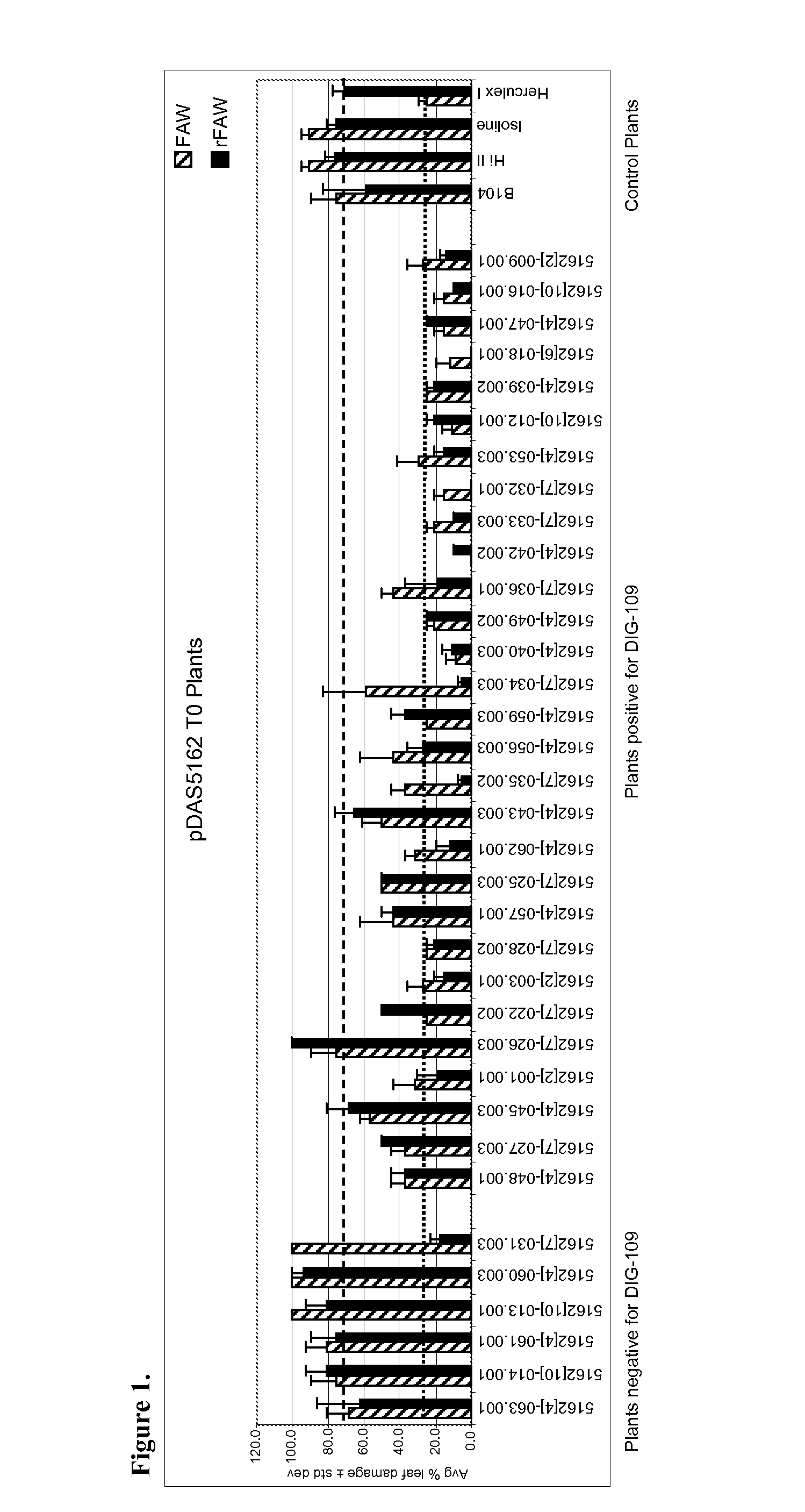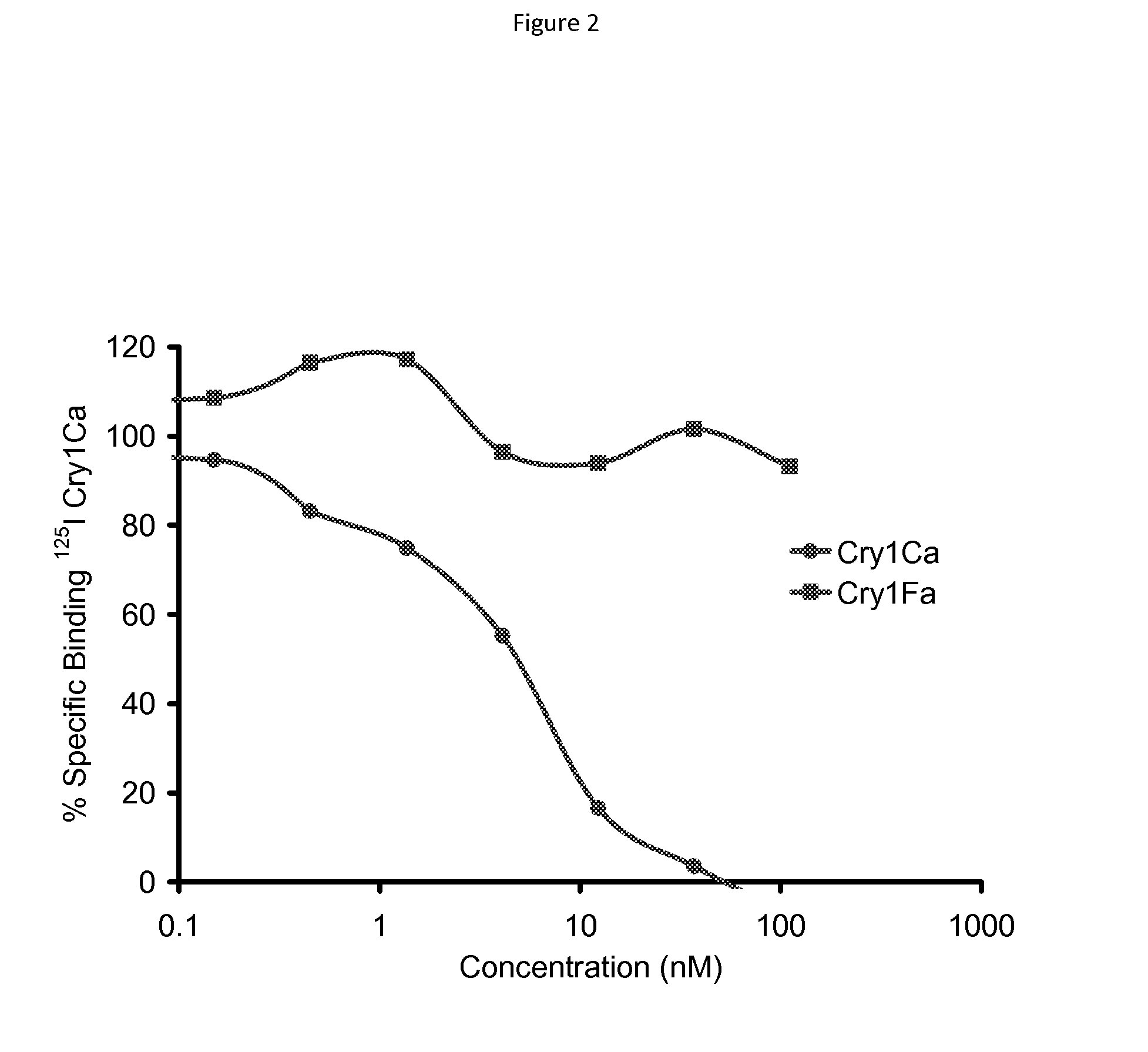COMBINED USE OF CRY1Ca AND CRY1Fa PROTEINS FOR INSECT RESISTANCE MANAGEMENT
a technology of insect resistance and cry1fa, which is applied in the field of combined use of cry1ca and cry1fa proteins for insect resistance management, can solve the problems of undermining human efforts, unable to conduct (competitive or homologous) receptor binding studies using cry1fa proteins, and additional billions lost to the damage they inflict, so as to reduce or eliminate the requirement for refuge acreage
- Summary
- Abstract
- Description
- Claims
- Application Information
AI Technical Summary
Benefits of technology
Problems solved by technology
Method used
Image
Examples
example 1
Design of Chimeric Cry1Ca Core Toxins and Cry1Ab Protoxins
[0088]Chimeric Toxins. Chimeric proteins utilizing the core toxin domain of one Cry toxin fused to the protoxin segment of another Cry toxin have previously been reported, for example, in U.S. Pat. No. 5,593,881 and U.S. Pat. No. 5,932,209. A Cry1Ca3 delta endotoxin protein sequence is deposited as GenBank Accession Number AAA22343 under an obsolete terminology of CryIC(b).
[0089]Cry1Ca chimeric protein variants of this invention include chimeric toxins comprising an N-terminal core toxin segment derived from a Cry1Ca3 insecticidal toxin fused to a heterologous delta endotoxin protoxin segment at some point past the end of the core toxin segment. The transition from the core toxin to the heterologous protoxin segment can occur at approximately the native core toxin / protoxin junction or, in the alternative, a portion of the native protoxin (extending past the core toxin segment) can be retained, with the transition to the heter...
example 2
Construction of Expression Plasmids Encoding Chimeric Cry1Ca Core / Cry1Ab Protoxin Proteins and Expression in Pseudomonas
[0092]Standard cloning methods (as described in, for example, Sambrook et al., (1989) and Ausubel et al., (1995), and updates thereof) were used in the construction of Pseudomonas fluorescens (Pf) expression construct pMYC2547 engineered to produce a full-length DIG-152 chimeric protein (as disclosed in SEQ ID NO:1). Protein production was performed in Pseudomonas fluorescens strain MB214 (a derivative of strain MB101; P. fluorescens biovar I), having an insertion of a modified lac operon as disclosed in U.S. Pat. No. 5,169,760. The basic cloning strategy entailed subcloning a DNA fragment encoding DIG-152 into plasmid vectors, whereby it is placed under the expression control of the Ptac promoter and the rrnBT1T2 terminator from plasmid pKK223-3 (PL Pharmacia, Milwaukee, Wis.). One such plasmid was named pMYC2547, and the MB214 isolate harboring this plasmid is n...
example 3
Insecticidal Activity of DIG-152 Protein Produced in Pseudomonas fluorescens
[0107]Insecticidal activity of the DIG-152 protein was demonstrated on larvae of the fall armyworm (FAW, Spodoptera frugiperda (J. E. Smith)) and on larvae of Cry1F-resistant FAW (rFAW).
[0108]Sample Preparation and Bioassays.
[0109]Inclusion body preparations (native full length protein or trypsin activated protein) were transferred to 10 mM CAPS pH10 buffer by exchange methods such as dialysis or PD-10 columns. The samples were then diluted appropriately in 10 mM CAPS pH 10, and all bioassays contained a control treatment consisting of this buffer, which served as a background check for mortality or growth inhibition.
[0110]Protein concentrations in bioassay buffer were estimated by gel electrophoresis using BSA to create a standard curve for gel densitometry, which was measured using a BioRad imaging system as above. Proteins in the gel matrix were stained with Coomassie Blue-based stain and destained befor...
PUM
| Property | Measurement | Unit |
|---|---|---|
| pH | aaaaa | aaaaa |
| pH | aaaaa | aaaaa |
| concentration | aaaaa | aaaaa |
Abstract
Description
Claims
Application Information
 Login to View More
Login to View More - R&D
- Intellectual Property
- Life Sciences
- Materials
- Tech Scout
- Unparalleled Data Quality
- Higher Quality Content
- 60% Fewer Hallucinations
Browse by: Latest US Patents, China's latest patents, Technical Efficacy Thesaurus, Application Domain, Technology Topic, Popular Technical Reports.
© 2025 PatSnap. All rights reserved.Legal|Privacy policy|Modern Slavery Act Transparency Statement|Sitemap|About US| Contact US: help@patsnap.com


